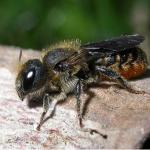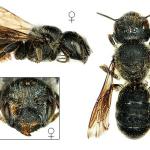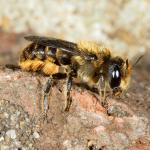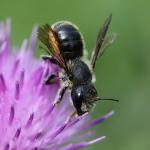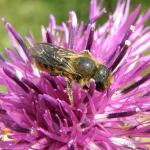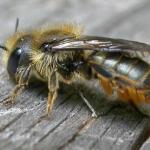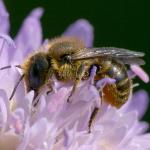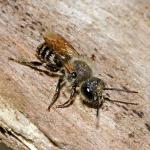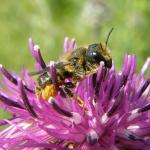Apis hirta Geoffroy in Fourcroy 1785; Osmia forsii ALFKEN 1924; Apis melodes HARRIS 1776; Apis tacitus HARRIS 1776; Apis ventralis PANZER 1798; Apis hirta GEOFFROY 1785; Osmia atra SCHENCK 1853; Osmia fulviventris SMITH1855; Osmia confusa MORAWITZ 1869; Osmia solskyi MORAWITZ 1870; Osmia truncatula THOMSON 1872; Osmia bidens PÉREZ 1879; Osmia forsii ALFKEN 1924
One of two small Osmia bees frequently occurring in gardens as well as woodland clearings and edges. The males of both O. leaiana and O. caerulescens are extremely hard to distinguish, being about 6mm long, shining metallic green and having bright ginger hairs when fresh. The best character is microscopic: look at the downward-sloping front surface of the first gastral tergite. It is shining in O. caerulescens and matt with reticulation in O. leaiana. This means that set specimens need to be arranged in order to see this feature. The females are quite different; both are about 10mm long, but O. caerulescens is generally smaller, dark blue with a black scopa under the abdomen and O. leaiana is generally larger, dark brown, with a bright orange scopa under the abdomen.
Restricted to England and Wales. It is less frequently found than O. caerulescens, but occurs in similar habitats. Overseas: Europe, although at higher altitudes in southern areas; also north-west Africa, also at higher altitudes.
The species may be encountered almost anywhere in England and Wales, but it requires cavities in dead wood, walls or cliffs for nesting.
This species may be found between May and August.
Nests in a variety of cavities, in walls, cliffs and dead wood. The nest closure and partitions are made from chewed plant material, bright green when fresh, which dries to a dark-brown, granular appearance.
Recorded visiting a wide variety of flowers from a number of different plant families for nectar, but oligolectic on Asteraceae for pollen.
The cleptoparasitic bee, Stelis phaeoptera, has been recorded as utilising this bee as a host (Westrich, 1989). It is likely that it is also attacked by the cuckoo-wasp Chrysura radians (Morgan, 1984).
Profile written: 2005
Proofed: February 2012


